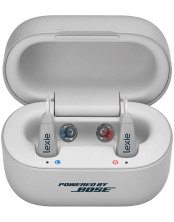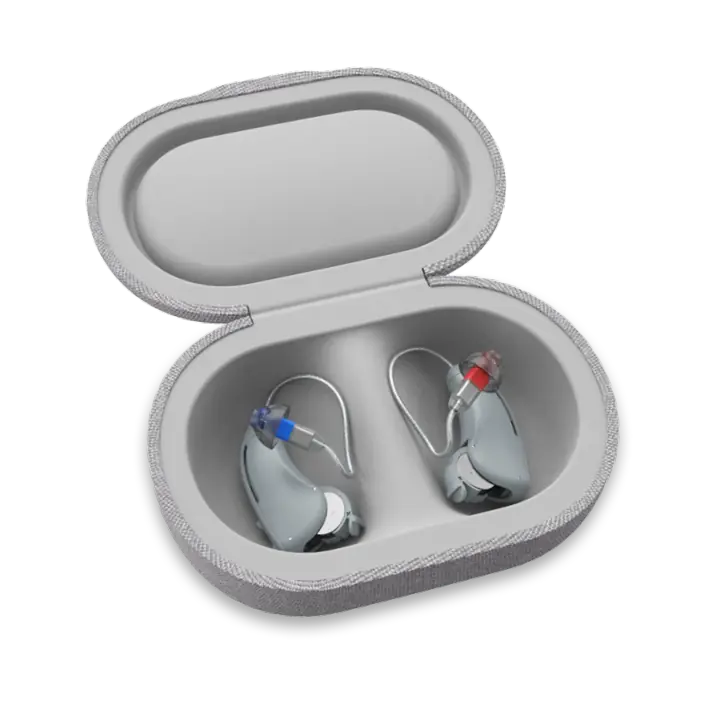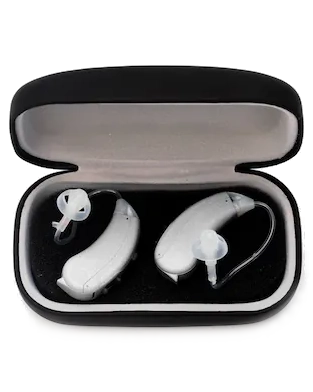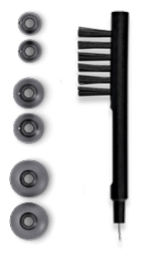CROS and BiCROS Hearing Aids
Published: November 5, 2021
With normal hearing, your brain can use information from both your ears to determine how far a sound is from you and what direction it is coming from. A common assumption regarding hearing loss is that it is always bilateral, but some individuals present with unilateral hearing loss. This suggests that they have decreased hearing in only one of their ears, and find themselves struggling to localize their environmental sounds. Over the years technology has continued to advance to enable an individual with a unilateral hearing loss, or when one ear is significantly worse than the other ear, to hear from both sides.
When one ear has a hearing loss, the other ear needs to compensate and process the information coming from all directions (left, right, front, and back). If for example your right ear is the better hearing ear and needs to process the sound signal, your head may block the sound coming from the left side similar to how it will block the sunlight. The sound would need to travel around your head to reach your right ear. This phenomenon is called the head shadow effect. The head shadow effect can cause you to miss out on important information as it causes a reduced sound signal to reach your stronger/hearing ear. Sounds that are perceived quieter become especially challenging to understand when in noisy listening situations.
How does it work?
CROS and BiCROS hearing aids commonly make use of a transmitter unit with a microphone on the “bad” ear and sends sound signals to the hearing, or better functioning ear where a hearing aid with a receiver is worn. This is done either wirelessly (most commonly), or with a wire and helps the CROS/BiCROS user experience a feeling closer to hearing with both ears.
So what’s the difference?
CROS Hearing Aids
CROS (Contralateral Routing of Signal) hearing aids are recommended for individuals who present with normal hearing in their better ear and have an unaidable hearing loss in the other ear. Some hearing experts would also base their recommendation on poor word recognition scores from the audiological test battery. The CROS hearing system takes sounds from the weak ear and transmits the sounds to the better and normal hearing ear. The CROS device has a transmitter in the weak ear that transmits the signal (mostly) wirelessly to the receiver in the better ear. The receiver looks and feels like a hearing aid, however, this device does not amplify the sound it receives. The receiver is only delivering the sound it has received from the weak ear to your better ear. This allows you to have binaural hearing i.e. hearing sounds that come from both sides of your head.
BiCROS Hearing Aids
The BiCROS (Bilateral Routing of Signal) is quite similar to the CROS hearing aid. The BiCROS transmitter picks up the sound on the “weaker” ear and sends the signal through to the active hearing aid on the “better” ear. The paired hearing aid not only receives the sounds from the transmitter but also amplifies the sounds that are received by the “better” ear as a typical hearing aid would do. The BiCROS system allows the user to process the stimuli in such a manner that they believe they’re hearing the sound in the “dead” ear.
A BiCROS system is typically recommended for a person who has an asymmetrical hearing loss. This is when you have a hearing loss in both ears, but one ear is significantly “better” than the other ear. This suggests you might have a mild to moderate hearing loss in one ear, but a profound hearing loss in the other.
Who will benefit from these devices?
CROS and BiCROS hearing aids are often fitted to individuals who suffer from normal to moderate hearing loss in one ear and no functional hearing in the other ear.
What are the benefits?
Benefits of these devices include:
- Improved sound quality and ability to identify sounds.
- The hearing experience feels more balanced.
- Better speech understanding.
- Improved sound localization.
- Assisting the CROS/BiCROS hearing aid user to better understand speech within noisy situations.
- Some device users have reported feeling less fatigued from listening to and following conversations.
These devices are not readily available over the counter or online. Most CROS and BiCROS users have found that an audiologist and Ear, Nose, and Throat specialist will provide better insight into these types of hearing aids and whether or not they would address your hearing needs. If you are interested in learning more and discussing how Lexie Hearing would be able to guide you, please do not hesitate to contact our hearing experts.






